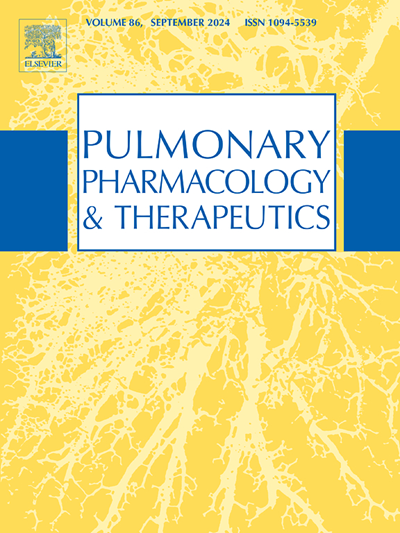Functional interplay between bradykinin receptors and transient receptor potential vanilloid-1 in lipopolysaccharide-induced acute lung injury in mice
IF 2.8
3区 医学
Q2 PHARMACOLOGY & PHARMACY
引用次数: 0
Abstract
In this study, we investigated the functional interplay between bradykinin receptors and the transient receptor potential vanilloid-1 (TRPV1) channel in a mouse model of acute lung injury (ALI) induced by lipopolysaccharide (LPS). Lung and bronchoalveolar lavages were collected at 6 and 24 h after the induction of ALI and evaluated for changes in body weight, inflammatory marker levels, lung injury, and TRPV1 expression. Pretreatments with a TRPV1 antagonist (capsazepine) or B1 and B2 receptor antagonists, i.e., DALBK and HOE 140, respectively, were evaluated in this ALI mouse model. The histological score revealed higher levels of lung injury in mice treated with LPS (5 and 10 mg/kg), assessed at both 6 and 24 h, compared to the vehicle-treated group. A loss of body weight was observed within 24 h of ALI induction. Furthermore, collagen deposition, pulmonary oedema, leukocyte influx, and increased cytokine levels were also observed following LPS administration. Pretreatment with capsazepine, DALBK, or HOE 140 not only reversed all inflammatory parameters but also prevented the increased expression of TRPV1 observed in the lungs of mice subjected LPS-induced ALI. Our data suggest that, following LPS-induced ALI, bradykinin activates both B1 and B2 receptors associated with the subsequent activation of TRPV1. These findings suggest that bradykinin can activate both B1 and B2 receptors, which may contribute functionally to TRPV1 upregulation and activation during LPS-induced ALI. This novel pathway appears to sustain inflammation, offering a new therapeutic target for ALI and ARDS.
缓激肽受体与瞬时受体电位香草素-1在脂多糖诱导的小鼠急性肺损伤中的功能相互作用
在本研究中,我们研究了缓激肽受体与瞬时受体电位香草素-1 (TRPV1)通道在脂多糖(LPS)诱导的急性肺损伤(ALI)小鼠模型中的功能相互作用。在ALI诱导后6和24小时收集肺和支气管肺泡灌洗液,评估体重、炎症标志物水平、肺损伤和TRPV1表达的变化。用TRPV1拮抗剂(辣椒平)或B1和B2受体拮抗剂(分别为DALBK和ho140)预处理ALI小鼠模型进行评估。组织学评分显示,LPS(5和10 mg/kg)处理的小鼠在6和24小时的肺损伤水平均高于给药组。在ALI诱导24小时内观察到体重下降。此外,胶原沉积、肺水肿、白细胞内流和细胞因子水平升高也在LPS处理后被观察到。用辣椒平、DALBK或ho140预处理不仅可以逆转所有炎症参数,还可以阻止lps诱导的ALI小鼠肺中TRPV1表达的增加。我们的数据表明,在lps诱导的ALI后,缓激肽激活了与随后激活TRPV1相关的B1和B2受体。这些发现表明,缓激素可以激活B1和B2受体,这可能在功能上有助于lps诱导的ALI中TRPV1的上调和激活。这种新途径似乎可以维持炎症,为ALI和ARDS提供新的治疗靶点。
本文章由计算机程序翻译,如有差异,请以英文原文为准。
求助全文
约1分钟内获得全文
求助全文
来源期刊
CiteScore
6.20
自引率
0.00%
发文量
41
审稿时长
42 days
期刊介绍:
Pulmonary Pharmacology and Therapeutics (formerly Pulmonary Pharmacology) is concerned with lung pharmacology from molecular to clinical aspects. The subject matter encompasses the major diseases of the lung including asthma, cystic fibrosis, pulmonary circulation, ARDS, carcinoma, bronchitis, emphysema and drug delivery. Laboratory and clinical research on man and animals will be considered including studies related to chemotherapy of cancer, tuberculosis and infection. In addition to original research papers the journal will include review articles and book reviews.
Research Areas Include:
• All major diseases of the lung
• Physiology
• Pathology
• Drug delivery
• Metabolism
• Pulmonary Toxicology.

 求助内容:
求助内容: 应助结果提醒方式:
应助结果提醒方式:


